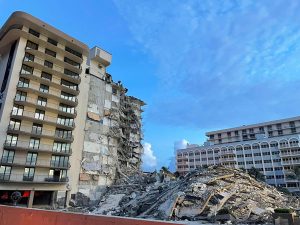It may be years before all the factors that resulted in the Surfside, Fla. condominium collapse in June are fully understood.
However, photos taken shortly before, and analysis undertaken in the weeks immediately afterward, may point to spalling in concrete beams and columns and possible conflicts between the design and execution of the rebar layout at critical junctions. Spalling is cracking and substrate delamination most commonly caused by the corrosion of embedded steel reinforcement bars or steel sections.
Any confirmation of concrete deterioration at Surfside may trigger interest in the latest real time monitoring methods of structural concrete components that go beyond mere visual inspections.
The subject has been the topic of considerable study. In June, researchers and academics from Brazil, Peru and Portugal published an overview of available fibre-optic (FOS) technologies, describing how FOS sensors can provide information concerning the onset of cracking and the evolution of strains caused by various factors. All these can affect the service life of a concrete component.
“As a heterogeneous material, made with constituents from different origins, concrete structures may exhibit pathologies during their useful life, due to both the applied loads and interaction with the environment.”
They explain deterioration in the micro or macro structure of concrete can result from the improper selection of aggregate types for cement for making concrete mixtures or from a delayed formation of some hydration products. Environmental actions, unforeseen stresses and external loads are also factors leading to reduced durability and long-term performance.
Structural health monitoring (SHM) of concrete using point sensors has been increasing. However, the researchers point to the advantages of fibre optic sensors, specifically their multiplexing capabilities, chemical stability, high sensitivity, resistance to electromagnetic fields and compactness.
FOS sensors have been tested and proven useful in the investigation of concrete deterioration under a number of scenarios: steel corrosion; concrete pavement slabs subjected to external temperature fluctuations; heat generated by cement hydration reactions that can impose thermal strains; mechanical strain; and crack widths.
The researchers explain how pre-embedded fibre optic concrete sensors can be incorporated into flat acrylic sheets, liquid epoxy, pairs of cast epoxy sheets and rod assemblies, each of which can be used for real-time monitoring of concrete structures.
Rebar layout design and execution is another critical factor that will be examined at the Surfside site.
Burkhard Rützel, product manager of German-based Allplan Engineering, points out 2D CAD programs continue be widely used for reinforcement design and detailing due to its familiarly and will likely continue to be so. However, he says traditional reinforcement design and analysis created in 2D CAD programs is fraught with issues.
“Working in this linear and fragmented way is extremely inefficient, requiring information to be duplicated at most stages,” he says. “Not only is there the potential for errors to be introduced at every handover between parties, there is also the risk of losing information when sharing data.”
However, Rützel says moving to 3D modelling would increase design efficiency and accuracy due to 3D’s ability to “recognize shapes and volumes as objects within a structure rather than just polylines and areas.”
“Another benefit of moving to 3D reinforcement modelling is the increased quality of the design and deliverables.”
For example, he says his company’s software can detect and highlight collisions automatically and fix errors and discrepancies before the design phase is completed.
Rützel says 3D reinforcement software integrated with Building Information Modeling (BIM) can result in more accurate quantity requirement reports.
“Choosing a software solution that supports BIM is a sound, future-proof decision. BIM can drive productivity and cost-savings throughout the entire project.”
The Surfside condominium may trigger changes in the way large structural concrete components are designed and monitored. New technologies can make that happen, whereas procrastination could lead to more tragic results similar to those seen in Florida.
As Rützel concludes, “If you do what you have always done, you will get what you have always had.”
John Bleasby is a Coldwater, Ont.-based freelance writer. Send comments and Inside Innovation column ideas to editor@dailycommercialnews.com.











Recent Comments
comments for this post are closed